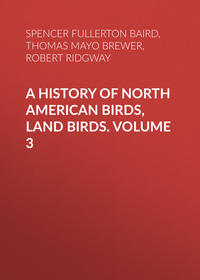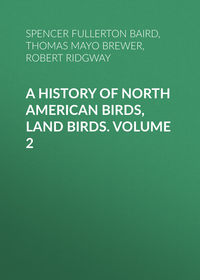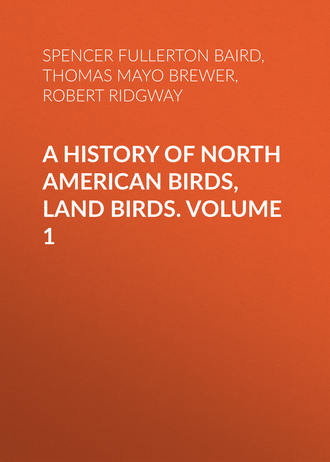 полная версия
полная версияA History of North American Birds, Land Birds. Volume 1
Mr. Nuttall found a nest of this species suspended from the forked twig of a wild crab-tree, about ten feet from the ground. The chief materials were dead and withered grasses, with some cobwebs agglutinated together, externally partially covered with a few shreds of hypnum, assimilating it to the branch on which it hung, intermingled with a few white paper-like capsules of the spiders’ nests, and lined with a few blades of grass and slender root-fibres.
Seven nests of this species, found in Lynn and Hingham, Mass., exhibit peculiarities of structure substantially identical. In comparison with the nests of other Vireos, they are all loosely constructed, and seem to be not so securely fastened to the twigs, from which they are suspended. One of these nests, typical of the general character, obtained in Lynn, May 27, 1859, by Mr. George O. Welch, was suspended from the branches of a young oak, about twelve feet from the ground. The external depth of this nest was only two and a half inches, the diameter three and a quarter, and its cavity one and three quarters inches deep, and two inches wide at the rim. It was constructed externally of strips of yellow and of gray birch-bark, intermingled with bits of wool and dry grasses. The external portion was quite loosely put together, but was lined, in a more compact manner, with dry leaves of the white pine, arranged in layers. Another nest, found in Hingham, was but two feet from the ground, on a branch of a hickory sapling. In its general structure it was the same, only differing in shape, being made to conform to its position, and being twice as long as it was broad. It contained four young, when found, about the 10th of June. One nest alone, built on a bush in Lynn, exhibits even an average degree of compactness in its external structure. This is largely composed of cocoons, which are woven together into a somewhat homogeneous and cloth-like substance. Within, decayed stems of grasses take the place of the usual pine-needles.
In the summer of 1870 a pair built their nest in a dwarf pear-tree, within a few rods of my house. They were at first very shy and would not permit themselves to be seen at their work, and suspended all labor when any one was occupied near their chosen tree. Soon after the construction of the nest two Cowbird’s eggs were deposited, which I removed, although the female only laid two of her own before she began to sit upon them. By this time she became more familiar, and would not leave her nest unless I attempted to lay hands upon her. She made no complaints in the manner of the White-eyed, nor sought to attack like the Yellow-throated, but kept within a few feet, and watched me with eager eyes, until I left her. Unfortunately, her nest was pillaged by a Black-billed Cuckoo, and I was unable to observe her feed her young, as I had hoped to do.
The eggs are of an oblong-oval shape, moderately pointed at one end, and of a white ground, less crystalline than in the other species of its kind. They are spotted pretty uniformly over the entire egg with dots of dark red and reddish-brown. They are usually five in number.
Lanivireo solitarius, var. cassini, BairdCASSIN’S VIREOVireo cassini, Xantus, Pr. A. N. S. Phil. May, 1858, 117.—Baird, Birds N. Am. 1858, 340, pl. lxxviii, fig. 1; Review Am. B. I , 1865, 347 (sub V. solitaria), Ridgway.
Sp. Char. Third and fourth quills nearly equal, fifth shorter, second longer than seventh. Spurious primary very narrow, falcate, acute; less than one third the second quill, and a little more than one fourth the third. Above, including edges of wing and tail-feathers, clear olive-green, becoming dusky ashy on the top and sides of head. Beneath fulvous-white, tinged with ill-defined olive-green on the sides (scarcely on the crissum). Two broad bands on the wing-coverts and the outer edges of the innermost secondaries greenish-white; the outer edge of outer tail-feather, with a broad ring round the eye, extending to a frontal band, dull white. Length about 5 inches; wing, 2.75; tail, 2.30.
Hab. Fort Tejon, Cal. (Xantus); West Humboldt Mountains, Nevada (Ridgway).
Since the type of this variety was obtained, two other specimens (Nos. 53,418 ♀ and 53,419 ♂, September, 1867; R. Ridgway) have been secured by the United States Geological Survey of the 40th Parallel, in command of Mr. Clarence King, in the West Humboldt Mountains, Nevada. These specimens are even more different from true solitarius than is the type of this race, showing that it is really distinct, as a variety. In the same thickets at the same season, perfectly typical specimens of V. solitarius were obtained; the latter having, no doubt, come from their more northern summer home on their passage southward into Mexico.
In the Humboldt Mountain specimens the crown shows no trace of ash, and is even darker and more brownish than the back. In fact, the relation of the V. cassini to V. solitaria is an almost exact parallel to that of V. josephæ to V. gilvus, as far as coloration is concerned, in each case the extreme being widely different, but connected by specimens showing intermediate characters.
Nothing is known of the habits of this race.
Lanivireo solitarius, var. plumbeus, CouesLEAD-COLORED VIREOVireosylvia plumbea, Coues, Pr. A. N. Sc. Phila. 1866 (Fort Whipple, near Prescott, Arizona).—Cooper, Orn. Cal. 1, 1870, 119.—Elliot, Illust. Birds N. A. I, vii. V. (Lanivireo) plumbea, Baird, Rev. 349.
Sp. Char. (No. 37,011.) Whole upper parts and sides of head uniform plumbeous; the lower part of the back with a faint wash of olivaceous. A white line from bill to and around eye; a dusky line from corner of eye to bill. Sides of breast and flanks plumbeous, paler than the back; the flanks very slightly tinged with olive-green. Rest of under parts white; the axillars ashy, edged with white. Wings above with two conspicuous white bands; the innermost quills edged externally and the longer ones internally with white, the latter edged externally with light ash. Bill and legs dark plumbeous, “Iris hazel.” Tail-feathers narrowly edged all round with white, narrowest internally, and increasing from central to lateral feathers. Upper tail-coverts clear ash.
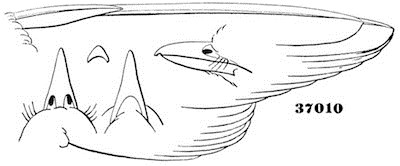
Vireosylvia plumbea.
37010
As the specimen in finest plumage (described above) is moulting the quills, the measurements are taken from another (37,010). In this the first quill is not quite one third the second, which equals the sixth, the third and fourth longest.
(No. 37,010.) Fresh specimen: Total length, 6.10; expanse of wings, 10.80. Prepared specimen: Total length, 5.75; wing, 3.25; tail, 2.70; difference between tenth and longest quill, .95; exposed portion of first primary, .75, of second, 2.34, of longest, third (measured from exposed base of first primary), 2.54; length of bill from forehead, .55, from nostril, .31, along gape, .70; tarsus, .75; middle toe and claw, .60, claw alone, .21; hind toe and claw, .50, claw alone, .23.
Hab. Southern Rocky Mountains; East Humboldt Mountains, Nevada (Ridgway). In winter to Colima, Mexico.
While the pattern of coloration is precisely similar to that of Lanivireo solitarius, the difference in the colors appears to be occasioned merely by removing, as it were, the yellow stain, which on the plumbeous produces the olive-green tinge, and exists in a purer tint along the sides, leaving, essentially, only clear plumbeous and pure white; there is, however, in the most typical specimens, always a faint tinge of green on the rump, and a stain of yellow along the side. Though identical with solitarius in most of its proportions, the wings and tail are considerably longer than in the average of that form.
There are many specimens from the Rocky Mountains and westward that are so decidedly intermediate between solitarius and plumbeus, that, considering also the lack of essential difference in form and coloration between the two, we do not hesitate to consider them, along with cassini and propinquus (see page 373), as races of a single species, of which each is the representative in a particular region. Thus, V. solitarius breeds in the Eastern Province of the United States (and possibly in the Western, following the same route far to the northward that many Eastern birds pursue in straggling westward), and migrates in winter into Middle America as far as Guatemala; those which breed in the Northwest pass directly southward, thus crossing the region where cassini and plumbeus breed, which accounts for their being obtained together. V. cassini is the representative on the opposite side of the continent; but the history of its migrations is yet obscure. V. plumbeus is the Middle Province and Rocky Mountain representative, breeding alone in that region, and in winter migrating southward through Western Mexico as far as Colima. V. propinquus is another permanent race, but a local one, being resident in the country where found, though mixed in winter with visitors of solitarius from the North.
Habits. Of this very recently discovered race, very little is at present known. It was first described by Dr. Coues, who met with it in Arizona, near Fort Whipple. He says it is especially abundant in the northern part of that Territory. It was by far the most common Vireo at Fort Whipple, where it is a summer resident, arriving there about the 15th of April and remaining until October.
It was found to be common about Laramie Peak, by Dr. R. Hitz, and was also met with in winter on the plains at Colima, Mexico, by Xantus.
It was seen in the summers of 1868 and 1869, by Mr. Ridgway, among the cedar and nut-pine woods on the slopes and among the brushwood in the cañons of the East Humboldt Mountains, being most partial to the former situations. There, too, it undoubtedly breeds, as in the latter part of July young birds, unable to fly, were met with by him. He also states that the common notes of this Vireo very closely resemble those of the Western Wood Wren (Troglodytes parkmanni).
Lanivireo flavifrons, BairdYELLOW-THROATED VIREOVireo flavifrons, Vieill. Ois. Am. Sept. I, 1807, 85, pl. liv.—Aud. Orn. Biog. II, 1834, pl. cxix.—Ib. Birds. Am. IV, pl. ccxxxviii.—Cassin, Pr. A. N. Sc. 1851, 149.—Sclater, P. Z. S. 1857, 227 (Vera Cruz); 1860, 257 (Orizaba).—Sclater & Salvin, Ibis, I, 1859, 12 (Guatemala).—Cab. Jour. III, 468 (Cuba; winter).—Gundlach, Cab. Jour. 1861, 324 (Cuba; rare).—Cab. Jour. 1860, 405 (Costa Rica). Vireo (Lanivireo) flav. Baird, Birds N. Am. 1858, 341. Vireosylvia (Lanivireo) flavifrons, Baird, Rev. 346. Muscicapa sylvicola, Wils. Am. Orn. II, 1810, 117, pl. vii, f. 3.

Vireosylvia flavifrons.
2217
Sp. Char. (No. 28,390.) Head and neck above and on sides, with interscapular region, bright olive-green. Lower back, rump, tail, and wing-coverts ashy. Wings brown, with two white bands across the coverts, the outer edges of inner secondaries, and inner edges of all the quills, with inside of wing, white. Outer primaries edged with gray, the inner with olive. Tail-feathers brown, entirely encircled by a narrow edge of white. Under parts to middle of body, a line from nostrils over eye, eyelids, and patch beneath the eye (bordered behind by the olive of neck) bright gamboge-yellow; rest of under parts white, the flanks faintly glossed with ashy. Lores dusky. Bill and legs plumbeous-black.
No spurious primary evident: second quill longest; first a little shorter than third.
Length, 5.80; wing, 3.00; tail, 2.00; difference of longest and innermost quills, .90; tarsus, .73.
Hab. Eastern United States, south to Costa Rica. Veragua (Salvin). Very rare in Cuba.
Autumnal birds, perhaps more especially the young, are more glossed with olivaceous, which invades the ashy portions, and tinges the white.
Habits. All the older ornithological writers, in speaking of the Yellow-throated Vireo, repeat each other in describing it as peculiarly attracted to the forest, seeking its solitudes and gleaning its food chiefly among its topmost branches. Such has not been my experience with this interesting and attractive little songster. I have found no one of this genus, not even the gilva, so common in the vicinity of dwellings, or more familiar and fearless in its intercourse with man. All of its nests that I have ever met with have been built in gardens and orchards, and in close proximity to dwellings, and they have also been exclusively in comparatively low positions. In one of the most recent instances a pair of these birds built one of their beautiful moss-covered nests in a low branch of an apple-tree that overhung the croquet-ground, within a few rods of my house. It was first noticed in consequence of its bold little builder flying in my face whenever I approached too near, even before its nest contained any eggs. The grounds were in frequent use, and the pair were at first a good deal disturbed by these constant intrusions, but they soon became reconciled to their company, and would not leave their position, even though the game was contested immediately under their nest, which was thus often brought within a foot of the heads of the players. Before this nest was quite finished, the female began her duties of incubation. Her assiduous mate was constantly engaged at first in completing the external ornamentation of the nest with lichens and mosses, and then with a renewal of his interrupted concerts of song. These duties he varied by frequent captures of insects, winged and creeping, most of which he duly carried to his mate. His song was varied, sweet, and touchingly beautiful. Less powerful than the notes of several others of its family, except those of the Warbling, I know of none more charming.
These birds reach New England about the 10th of May, and usually have their nests constructed early in June. Their habits, in all essential respects, are the same as those of all its family. They are somewhat confiding and trustful of man, are readily approached, and soon become so well acquainted with those among whom they have a home as to fearlessly come to the windows of the house in pursuit of spiders or flies, and even to enter them. In the latter case they cannot readily make their exit, and soon lose their self-possession, beating their heads against the walls and ceiling in vain attempts to get out, unless caught and released. In one instance a young bird, that had entered my barn-chamber, became so entangled in cobwebs, around his wings and feet, as to be unable to escape again. When taken in the hand, and his meshes one by one picked out from about his feet and quills, he was very docile, made no resistance or outcry, nor any attempt to escape, until he was entirely freed from his bonds, although it required some time and care to accomplish it. When entirely freed from these clogs, and permitted to go, he flew away very deliberately to a short distance, and occupied himself with dressing his disordered plumage.
The nest of this species is also a pendent structure, and hemispherical in shape. It may always be readily distinguished from any other nest of this family by the profusion of lichens and mosses with which its outer portion is adorned and covered, giving it the appearance of a large moss-covered knot.
In most of the towns in the vicinity of Boston this species, though not abundant, is quite common. Their nests, built usually in low and rather conspicuous positions for birds of this kind, occur most frequently in gardens and orchards. One of these, found suspended from a moss-covered branch of an apple-tree in Roxbury, may be taken as typical of its kind. Its rim was firmly bound around the fork of a branch by a continuation of the materials that form the outside of the nest itself. These are an interweaving of spiders’-webs, and silky threads from insect cocoons, largely intermingled with mosses and lichens, and thus made to conform closely in appearance to the moss-grown bark of the tree. The under portion of the nest is strengthened by long strips of the inner bark of the wild grape. Within is an inner nest made of fine grassy stems and bark. It forms exactly a half-sphere in shape, is symmetrical, and is very thoroughly made. Its diameter is four, and its height two and one fourth inches.
Mr. Nuttall describes a nest of this bird, found by him suspended from the forked twig of an oak, near a dwelling-house, as coated over with green lichens, attached very artfully by a slender string of caterpillars’ silk, the whole afterwards tied over by almost invisible threads of the same, so nicely done as to appear to be glued on. The whole fabric was thus made to resemble an accidental knot of the tree, grown over with moss. Another nest, observed by the same writer, was fixed on the depending branches of a wild cherry, and was fifty feet from the ground. So lofty a position as this is probably very unusual. I have never met with any higher than ten feet from the ground.
The food of this Vireo is chiefly insects, and in the breeding-season is altogether so. Later in the season they mingle with these various kinds of small berries.
The eggs of this species vary from .95 to .88 of an inch in length, and from .65 to .60 in breadth. Their ground-color is white, often with a very perceptible tint of roseate when fresh. In this respect they differ in a very marked manner from the eggs of any other of this genus, except, perhaps, the barbatula, and may thus always be very easily recognized. They are more or less boldly marked with blotches of a dark roseate-brown, also peculiar to the eggs of this species, though varying greatly in their size and depth of color.
This Vireo winters, in great numbers, in Central America, and was largely represented in the collection of Dr. Van Patten from Guatemala. It was also found at Pirico, in Colombia, South America, by Mr. C. W. Wyatt. It occurs in abundance as far to the west as Grinnell, Iowa, where Mr. W. H. Parker found it to be a very common summer resident.
Subgenus VIREO, VieillVireo, Vieill., Ois. Am. Sept. I, 1807, 83. (Type, Muscicapa noveboracensis, Gm.)

Vireo noveboracensis.
29248
Char. Wings short and rounded, a little longer than the tail, equal to it, or shorter. First primary distinct and large, from two fifths to half or more the length of the second, shorter or not longer than the eighth.
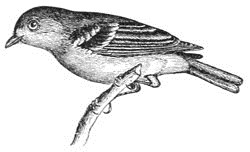
Vireo noveboracensis.
The characters of Vireo are essentially those of Vireosylvia; the bill, however, is shorter; the first quill always present, better developed, sometimes more than half the second. The wings are shorter, and more rounded; the tarsi usually longer. The, sections are as follows:—
Vireo. Wings pointed; first quill less than half the second, which is about equal to seventh or eighth, and decidedly longer than the tenth primary and the secondaries. Type, V. noveboracensis.
Vireonella. Wings rounded, scarcely longer than the tail; the first quill half as long as the second (or more than half), which is not longer than the tenth primary and secondaries, or even less. Bill and feet generally much stouter than the preceding. Type, V. gundlachi.
None of the species of Vireonella are found in the United States.
SpeciesCommon Characters. All the species olivaceous or ashy above, beneath whitish, or olivaceous-yellow. Wings with light bands. A light stripe from bill over the eye, but not beyond it, except in carmioli. Iris brown, as far as known, except in V. noveboracensis, where it is white.
A. Two conspicuous light bands on wing.
a. Sexes different. Whole lore white.
1. V. atricapillus. Above olive-green, outer edges of tail-feathers bright yellowish-green; wing-bands greenish-white. Sides olivaceous-yellow. Male. Head and neck (except lore, orbital ring, chin, and throat) deep black; lower parts pure white medially. Female with the black replaced by dull slate; lower parts ochraceous-white medially. Wing, 2.30; tail, 1.80; tarsus, .68; bill, from nostril, .24. Hab. Southern Texas; Mazatlan, Mexico.
b. Sexes alike. Lore dusky, with light mark above it.
2. V. carmioli.78 Above brownish olive-green. Beneath, with supra-loral stripe, orbital ring, and light markings on the wings, light ochrey-yellow more whitish on the throat. Wing, 2.55; tail, 2.00; tarsus, .66; bill, .26. Hab. Costa Rica.
3. V. noveboracensis. Above olive-green, ashy across the nape. Supra-loral stripe and orbital ring deep yellow. Beneath ashy-white on throat, purer white on abdomen; sides, and a tinge across the breast, light yellow. Iris white. Wing, 2.40; tail, 2.00; tarsus, .63; bill, .26. Hab. Eastern Province of United States, south (in winter) to Guatemala (and Bogota?); very rare in Cuba; abundant and resident in Bermuda.
4. V. huttoni. Above grayish-olive, more olive-green toward tail. Below pale grayish-buff. Orbital ring very broad, yellowish-white. Wing, 2.50; tail, 2.05; tarsus, .67; bill, .24. Hab. California; in winter, Western Mexico to Oaxaca.
B. Only one band on wing, and this indistinct.
5. V. belli. Above ashy-olive, more virescent posteriorly. Markings on side of head not well defined. Below dull white, with a slight buffy tinge, strongly stained with yellow on sides and flanks. Upper feathers of middle row of wing-coverts passing into paler at tip, producing an indication of an anterior band. Wing, 2.20; tail, 1.80; tarsus, .69; bill, .25. Hab. Plains between the Mississippi Valley and the Rocky Mountains, from Dakota to Texas; in winter south to Tehuantepec, Mexico.
6. V. pusillus. Above grayish-ash, very slightly tinged with olive on rump. Below dull white, ashy laterally, the flanks with the slightest possible tinge of yellow. Wing, 2.30; tail, 2.20; tarsus, .69; bill, .24, .13 deep. Hab. Arizona; Cape St. Lucas, Lower California; California north to Sacramento City.
7. V. vicinior. Above bluish-ash, below ashy-white, scarcely more ashy laterally. Lores entirely ashy-white. Wing, 2.60; tail, 2.40; tarsus, .67; bill, .26, .18 deep. Hab. Fort Whipple, Arizona.
Vireo atricapillus, WoodhouseBLACK-CAPPED VIREOVireo atricapillus, Woodhouse, Pr. A. N. Sc. 1852, 60 (San Pedro, Tex.).—Ib. Sitgreaves’s Rep. 1853, 75, pl. i, Birds.—Cassin, Illust. 1854, 153, pl. xxiv.—Baird, Birds N. Am. 1858, 337; Rev. 353.—Cooper, Orn. Cal. 1, 1870, 121.
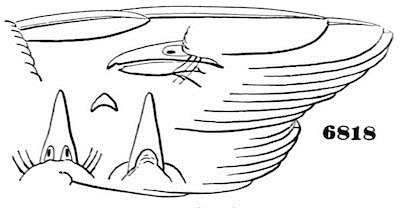
Vireo atricapillus.
6818
Sp. Char. (No. 6,818.) Top and sides of head and neck black; rest of upper parts olive-green. Wing and tail feathers almost black on their upper surface, the quills and rectrices edged with olive (paler on the exterior primaries), the wing-coverts with two greenish-white bands on a blackish ground. Broad line from bill to and around eye (not meeting on forehead) with under parts white; the sides of body olivaceous; the axillars and inner wing-coverts (perhaps crissum) yellowish. Bill black; feet plumbeous; iris bright red. First quill less than half the second, which about equals the tenth; third little shorter than fourth (longest).
Female. With the black replaced by dull slate; lower parts ochraceous-white medially. Possibly a distinct species (Mazatlan).
(No. 6,818.) Fresh specimen: Total length, 4.75; expanse of wings, 7.25; wing from carpal joint, 2.12. Prepared specimen: Total length, 4.10; wing, 2.25; tail, 1.95.




